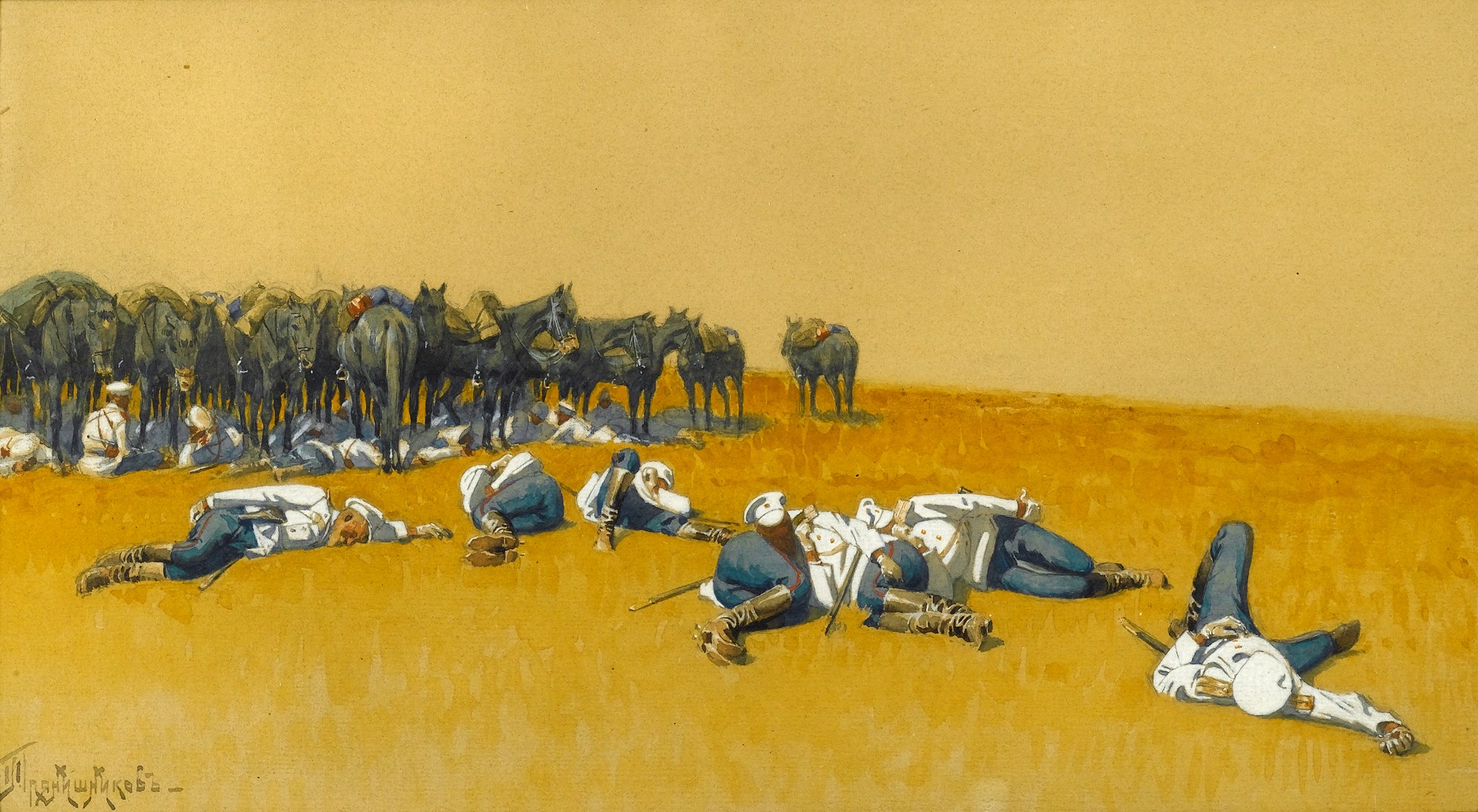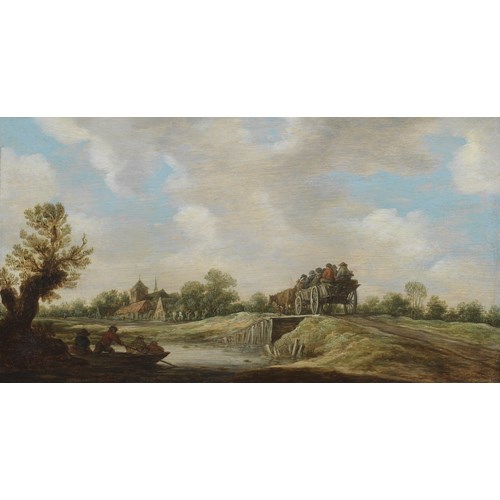Marketplace
Resting Troops
Ivan Petrovich Prianishnikov
Resting Troops
Epoque 1850-1900, 19th century, 20th century
Origine Russia
Medium Pencil, Watercolour, On buff paper
Dimension 14.6 x 27 cm (5³/₄ x 10⁵/₈ inches)
Seeking rest and shelter from the heat, most of the soldiers crouch or lie in the shadow of their horses. The animals’ legs, regimented and orderly, are like slender tree trunks in a forest, and the mass of their black bodies like the cool canopy above. The shaded figures in Ivan Petrovich Prianishnikov’s Resting Troops stand in contrast to those unfortunate soldiers who lie exposed to the heat; their scattered bodies, with limbs splayed, are almost symbolic of their impending fate. Prianishnikov has not individualised the soldiers and so these anonymous figures represent the suffering to which the whole Russian army is exposed in the glaring heat of the sun. The desert is painted in intense shades of yellow, which conveys the scorching heat, and because no object interrupts the line of the horizon the feeling of an endless, barren landscape is emphasised.
The uniforms worn by the troops suggest that they are Cossacks, who made up the majority of the Russian army’s cavalry, probably during the time of the Russo-Japanese War (1904-1905).¹ The Russian army adapted their uniforms to the dramatic variations of the weather that occurred across their vast empire and here we see them in the white gimnasterkas and peaked hats that were necessary in summer conditions, as opposed to the heavy greatcoat and tall fleece hat which were used in the harsh Russian winters. Prianishnikov has depicted the landscape as harsh and unforgiving, and the strength of the Russian cavalry was partly negated during the Russo-Japanese War because of the bleak and inhospitable nature of the terrain that they had to negotiate.
Resting Troops is a typical example of Prianishnikov’s work in that it deals with the daily life of the Russian military. As can be seen in the present work and other examples, Prianishnikov liked to portray the army during its less frenzied moments, such as during marches or rests, rather than during the heat of battle. The present work is comparable to His Majesty’s Life-Guard Cossack Regiment on Manoeuvres, (1888, Private Collection) which shows soldiers taking a rest from marching across a vast desert. Once more, the terrain is a dry, barren wilderness and Prianishnikov has used his favoured medium of watercolour to capture the effects of the baking sun. There is a sense of quiet in both works, as if the figures are trying to conserve their energy in the oppressive heat.
Although biographical details are relatively scarce, it is known that Prianishnikov spent much of his life in the U.S.A. and France, though he exhibited frequently in Russia throughout the 1880s. His scenes of military life were often reproduced in journals throughout Europe, such as Niva, a ‘journal of literature, politics, and public life’ which was notable for the quality of its illustrations, and to which many of the leading luminaries of Russian art also contributed.
¹ See Ivanov, A. & Jowett, P., The Russo-Japanese War 1904-05 (Osprey Publishing, Oxford, 2004), p.34.
The uniforms worn by the troops suggest that they are Cossacks, who made up the majority of the Russian army’s cavalry, probably during the time of the Russo-Japanese War (1904-1905).¹ The Russian army adapted their uniforms to the dramatic variations of the weather that occurred across their vast empire and here we see them in the white gimnasterkas and peaked hats that were necessary in summer conditions, as opposed to the heavy greatcoat and tall fleece hat which were used in the harsh Russian winters. Prianishnikov has depicted the landscape as harsh and unforgiving, and the strength of the Russian cavalry was partly negated during the Russo-Japanese War because of the bleak and inhospitable nature of the terrain that they had to negotiate.
Resting Troops is a typical example of Prianishnikov’s work in that it deals with the daily life of the Russian military. As can be seen in the present work and other examples, Prianishnikov liked to portray the army during its less frenzied moments, such as during marches or rests, rather than during the heat of battle. The present work is comparable to His Majesty’s Life-Guard Cossack Regiment on Manoeuvres, (1888, Private Collection) which shows soldiers taking a rest from marching across a vast desert. Once more, the terrain is a dry, barren wilderness and Prianishnikov has used his favoured medium of watercolour to capture the effects of the baking sun. There is a sense of quiet in both works, as if the figures are trying to conserve their energy in the oppressive heat.
Although biographical details are relatively scarce, it is known that Prianishnikov spent much of his life in the U.S.A. and France, though he exhibited frequently in Russia throughout the 1880s. His scenes of military life were often reproduced in journals throughout Europe, such as Niva, a ‘journal of literature, politics, and public life’ which was notable for the quality of its illustrations, and to which many of the leading luminaries of Russian art also contributed.
¹ See Ivanov, A. & Jowett, P., The Russo-Japanese War 1904-05 (Osprey Publishing, Oxford, 2004), p.34.
Epoque: 1850-1900, 19th century, 20th century
Origine: Russia
Medium: Pencil, Watercolour, On buff paper
Signature: Signed in Cyrillic (lower left)
Dimension: 14.6 x 27 cm (5³/₄ x 10⁵/₈ inches)
Plus d'œuvres d'art de la Galerie









